
| Manufacturer: | Sylvania |
| Model: | Mini-Lynx Pastel - Rose |
| Application: | General Lighting - decorative |
| Wattage: | 15W (14W measured) |
| Diameter (max): | 55mm |
| Length: | 165mm |
| Tube Length: | 360mm |
| Bulb/Tube material: | Glass, phosphor coating on inner wall, unknown composition, plus pale yellow dye |
| Colour Temperature: | Unknown |
| Peak output wavelength: | N/A |
| Total light output: | 640Lm (Manufacturer's claim - 42.7Lm/W) |
| Rated lifetime: | 12,000 Hours |
| Cap: | B22 |
| Operating voltage: | 220-240V AC 50Hz |
| Operating current: | 110mA |
| Warmup/restrike time: | 2 minutes/none |
| Cost (original): | £15 Approx |
| Place of manufacture: | United Kingdom |
| Date of manufacture: | July 1996 |
| Lamp Status: | Working |
| Related Pages |
By the early 90s, compact fluorescent's were starting to attain a foothold in the market...but not to a huge extent. They still tended to be bought by either the very environmentally conscious individuals or the energy-cost-conscious industrial sector. In fact, it's in a hotel that I first think I saw a CFL (which I now know to have been a Philips PL-C), as the energy savings and long lifetime there allowed twofold savings. The energy saving coupled with a reduced maintenance cycle would have presented an attractive saving, especially in a large hotel.
However, the fact that CFLs at that point in time tended to come in 3000K neutral white or 2700K warm white...with a colour rendering index in the mid 80s. Whereas this was the point that lighting manufacturers had just come up with the idea of making incandescent lamps with all kinds of colour tints to them, I distinctly recall seeing peach, apricot, rose, peppermint and bluish tints on the shelves in the supermarket. I can't remember what they called the blue one though. While this was a short-lived fad (though the peach ones seem to live on), it was a fad that was in progress while CFL manufacturers were trying to get into the market. When it was "trendy" to have tinted lighting in your house, this was one more thing putting the masses off buying those "boring" white CFLs. Sylvania however decided to see if a similar idea could work with CFLs, resulting in a variety of industrial lamps with lower than normal colour temperatures. While this was moderately successful, the very high price of the control gear and the lamps, plus the lack of convenience in having to use an external ballast, meant that it had little impact on the home consumer though.
As a result of this, Sylvania released two lamps based around the extra-warm phosphor formulation they had created for the commercial lamps, applying that phosphor to their existing Mini-Lynx electronically ballasted integrated lamps. Two versions were released, an apricot and a rose (featured here) version, both in 11W and 15W form (okay...so that's actually four versions...you know what I meant though!). While this was a high quality lamp, and did what it claimed to very, very well...Sylvania's relatively small presence outside the professional sector and the relatively high price of these lamps meant that sales figures never really took off. Unfortunately, this led to a very interesting range of lamps being withdrawn after only a few years.
The phosphor formulation of this lamp presently remains a mystery to me (though if you have anything to input to that, I'd welcome the information), though the function of the yellow dye (I assume it's dye - the phosphor may simply have a naturally yellow base colour though) is pretty clear. It reduces the intensity of the blue emission of the lamp (as the spectroscope photo below shows, the usual triphosphor emission in the mid blue is completely absent, that's visible even with my home made spectroscope), therefore increasing the relative red output of the lamp, lowering the colour temperature. The distinctly (I would actually have said peach) colour of the light output shows however that it's much more than just a yellow coating on a normal colour 827 (warm white) compact fluorescent. I am however at a loss to make any suggestion to the chemical makeup of the phosphor. The attenuation of the blue output however does have a negative impact on luminous efficacy, lamps of this wattage generally coming in at somewhere between 50 and 60Lm/W, this one only managing to reach the low 40s. Still far, far better than colour-corrected (or not for that matter!) incandescent lamps which it was competing against.
Electrically, there is nothing particularly noteworthy of this lamp. It's a conventional rapid-start electronically ballasted compact fluorescent. The ballast appears to run quite cool though compared to most cheap modern lamps.
An interesting detail visible in the photo of the packaging is that there's a transparent pale pink plastic sleeve which fits over the tube when in the packing. One must assume that this is intended to let the buyer know that it's rose coloured...not yellow as it appears when unlit. That would have been quite capable of confusing someone who has no idea of how phosphors work.
A very interesting lamp to have in the collection, especially given that they're now no longer in production. A real shame that, as I'd probably use one in the up-lighter in the lounge if they were still available.

Sylvania Mini-Lynx 15W Pastel Rose Colour Tinted Compact Fluorescent Lamp - General overview
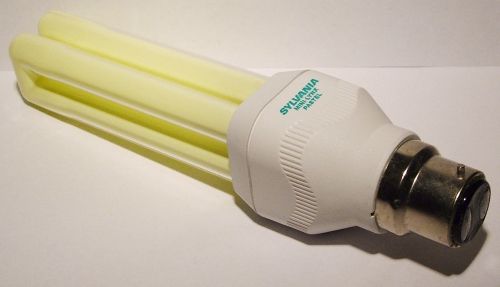
Sylvania Mini-Lynx 15W Pastel Rose Colour Tinted Compact Fluorescent Lamp - Detail of lamp cap
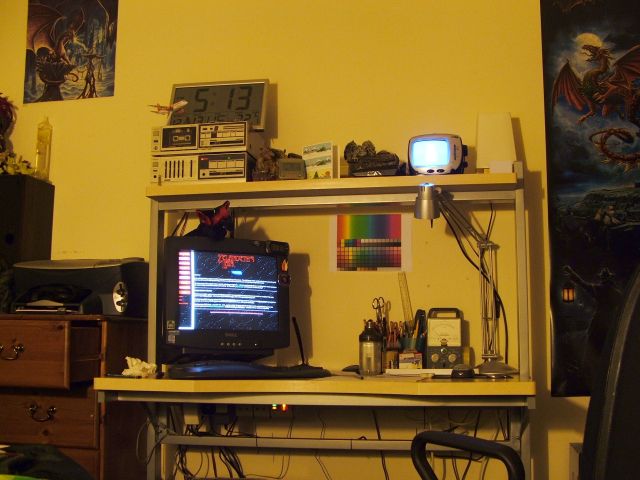
Sylvania Mini-Lynx 15W Pastel Rose Colour Tinted Compact Fluorescent Lamp illuminating my workstation from a distance of approximately two metres
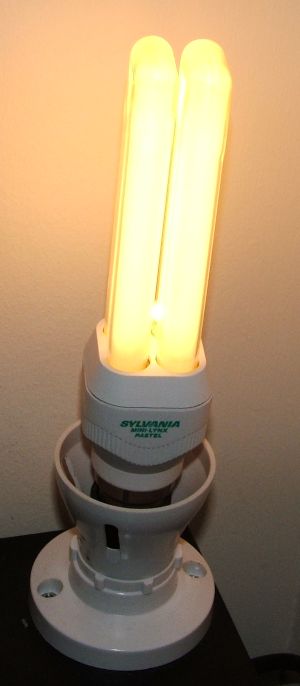
Sylvania Mini-Lynx 15W Pastel Rose Colour Tinted Compact Fluorescent Lamp - Overview of lamp while alight
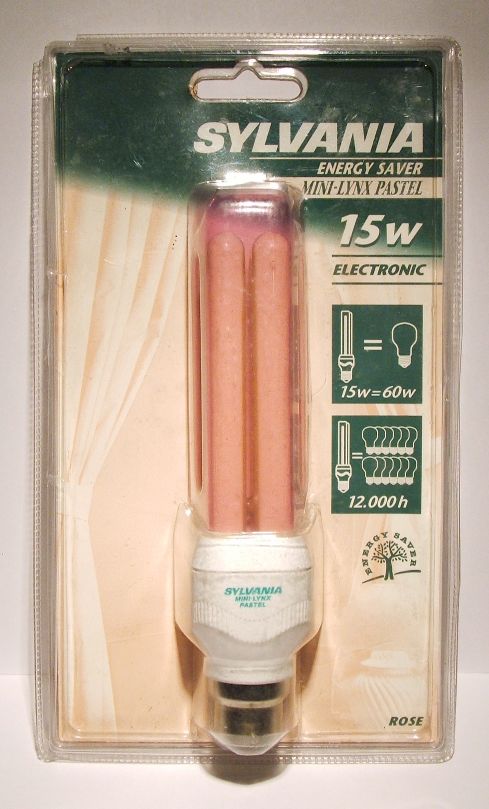
Sylvania Mini-Lynx 15W Pastel Rose Colour Tinted Compact Fluorescent Lamp - Overview of lamp packaging. Note pink coloured sleeve over the arc tube
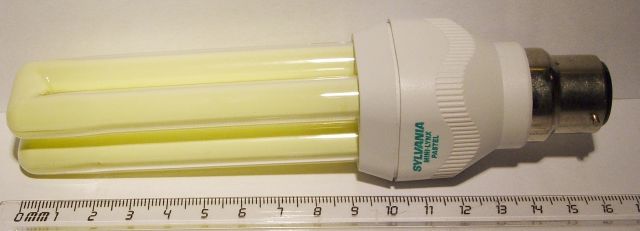
Sylvania Mini-Lynx 15W Pastel Rose Colour Tinted Compact Fluorescent Lamp - Displayed next to a ruler to show length of lamp

Sylvania Mini-Lynx 15W Pastel Rose Colour Tinted Compact Fluorescent Lamp Output Spectra
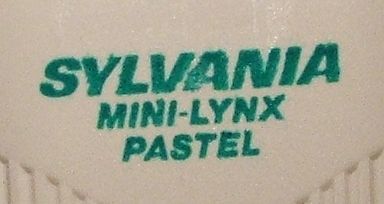
Sylvania Mini-Lynx 15W Pastel Rose Colour Tinted Compact Fluorescent Lamp - Detail of text printed on lamp base (1/2)
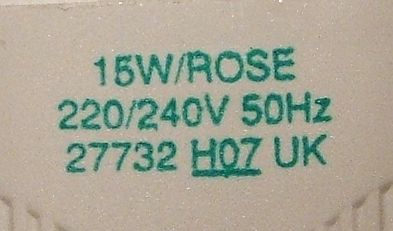
Sylvania Mini-Lynx 15W Pastel Rose Colour Tinted Compact Fluorescent Lamp - Detail of text printed on lamp base (2/2)
This lamp added to the Virtual Display Shelf on the 14th December 2006 at 21:12.
References: Lamp packaging and markings only. A lot of my knowledge of this lamp also came from a page on Lamptech, a website run by a fellow lighting collector and enthusiast.
Acknowledgements: Many, many thanks to the reader of this website who donated this lamp I had been seeking for so long for display!
This page last updated:
16th June 2023: Made changes to page formatting to improve readability on mobile devices. Also made some background page code changes to improve search engine behaviour.